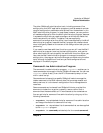
Chapter 2 95
Introduction to SNAplus2
SNAplus2 Resources
With DDDLU, LUs do not have to be configured statically at the host.
(You must still define dependent LUs on the SNAplus2 node.) This
reduces the initial configuration required at the host, and makes later
expansion easier.
SNAplus2 can communicate with both DDDLU-capable and
non-DDDLU-capable hosts, with no difference in the configuration
required. When the communications link from the SNAplus2 node to the
host is established, a DDDLU-capable host informs the node that it
supports DDDLU; the node then sends the required information to
define the dependent LUs that use the link. If the host is not
DDDLU-capable, SNAplus2 does not send this information; it assumes
that the LUs have already been defined statically at the host.
LU Pools. Type 0–3 LUs can also be grouped into LU pools, so that a
user session can be assigned to a pool of LUs. For 3270, RJE, and LUA
applications, you can use LU pools to simplify configuration and give
greater flexibility.
All of the LUs in a pool must be the same type. For example, you can
define several 3270 display LUs in a single LU pool, then configure
multiple 3270 display sessions using this LU pool. This makes
configuring 3270 sessions easier and enables any 3270 session to use any
LU in the pool.
LU pools can also span multiple SNAplus2 servers—just define LU pools
with identical names on the different servers. Clients that use the LU
pool can then use any server. This means that the clients can still be
used if a server fails or is taken out of service. Using LU pools also
simplifies client configuration and makes it easy to increase capacity by
adding another server or by adding LUs on an existing server.
LU pools support the following operations:
• Assigning LUs to users on a “first come, first served” basis when there
are more users than LUs.
• Balancing the traffic from user sessions across multiple servers or
multiple host links, by defining a pool containing LUs on more than
one node or on more than one host link.
• Permitting access to more than one host system from the same
configuration, so that if one host system becomes unavailable,
sessions can still be established to another system without requiring
reconfiguration.


















